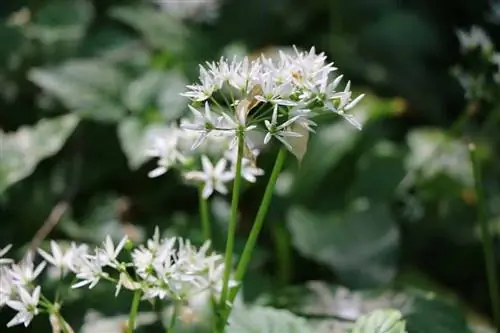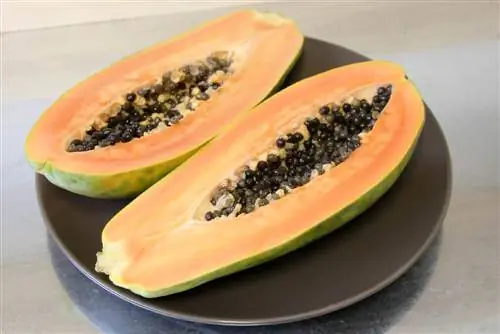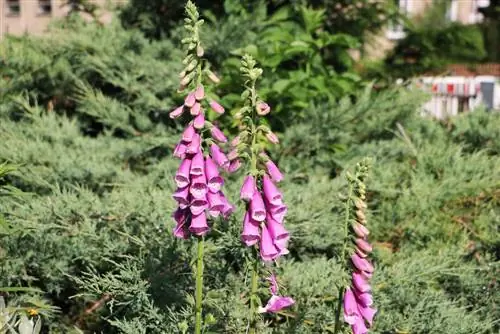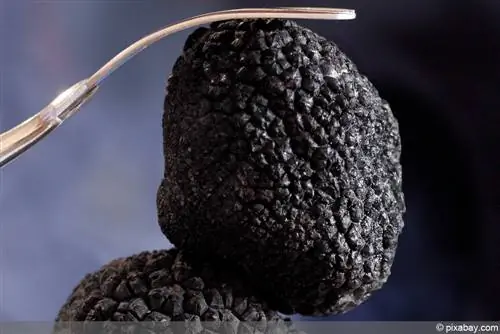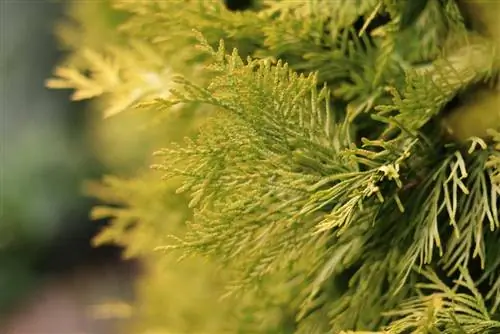- Author admin [email protected].
- Public 2023-12-17 03:39.
- Last modified 2025-10-04 22:41.
Forests in this country are mostly so-called commercial forests; the trees are used as lumber for houses and furniture or as firewood. It is often forgotten that it is an amazing ecosystem that is home to many different flowering and green plants (and animals). But not every forest is the same, it's not just the trees that vary, but all the plants in the forest.
How are forest plants classified?
On the one hand, forests are divided into deciduous, mixed and coniferous forests according to the type of trees they contain. Other forest plants can also be classified according to their height. If you look at the forest like a house, then the root area forms, so to speak, the basement in which various animals live; green plants cannot be found there. The ground layer forms the ground floor. Lichens, mosses and mushrooms (probably the most frequently consumed plants in the forest) grow here. The first floor with numerous plant species is called the herb layer. It is about 1.50 meters high. Herbs, grasses, ferns and flowering plants can be found here. The shrub layer, the second floor, is very species-rich and reaches a height of around five meters. The tree layer forms the attic.
Fouling of the soil layer
The soil usually has a lot more life than you realize at first glance. In addition to insects and microorganisms, you can also find beautiful forest plants on the forest floor.
Moose
Cypress or dormouse moss (Hypnum cupressiforme)
- used to be dried and used as pillow filling
- very shapely and variable in appearance
Swanneck star moss (Mnium hornum)
- 2 to 5 cm high
- likes to spread out like a lawn
Mushrooms
Fly Agaric (Amanita muscaria)

- poisonous, intoxicating drug
- in deciduous and coniferous forests
- I like birch and spruce trees
Ball mushroom (Amanita phalloides)
- deadly poisonous
- in deciduous forests
Chestnut Boletus (Boletus badius)
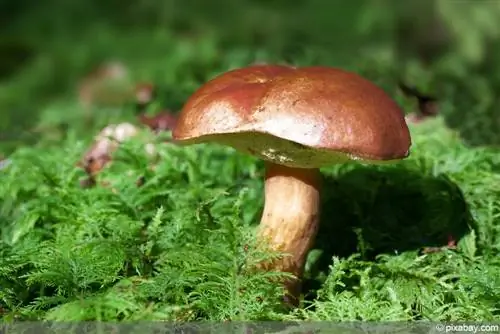
- edible
- preferred in coniferous forests (spruce and pine)
Chantarellus (Cantharellus cibarius)
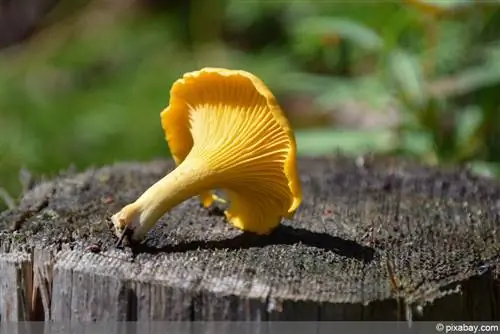
- edible
- mossy soils in deciduous and coniferous forests
Boletus(Boletus edulis)

- edible
- in deciduous and coniferous forests
Forest mushroom (Agaricus silvaticus)
- edible
- in coniferous forests, preferably with spruce trees
Tip:
Only collect mushrooms that you know really well, many edible varieties have an inedible or even poisonous counterpart. You can deepen your knowledge and learn a lot about mushrooms at special mushroom seminars.
Low flowering plants
Elf Flower, Sock Flower (Epimedium)
- Height: 20 to 35 cm
- Leaves: ovate to ovate-lanceolate, serrate edge, basal or distributed along the stem
- Flowers: white, yellow or pink, delicate, fourfold
- Flowering time: Early summer
Common hazelroot, witch's smoke, envy, glandwort (Asarum europaeum)
- Location: preferred in deciduous and mixed forests
- Leaves: rounded to kidney-shaped, underside hairy
- Flowers: pitcher-shaped, brown-red, with 3 lobes
- Flowering time: March to May
- Special features: evergreen, smells slightly peppery
Wood sorrel (Oxalis acetosella)

- Location: preferred in mixed and coniferous forests
- Height: 5 to 15 cm
- Leaves: grass-green, three-part, clover-like pinnate, taste sour
- Flowers: white or pink
- Flowering time: April to June
Fouling of the herb layer
Not only are there many creatures hiding in the forest, but also many plants. If you walk in the forest with your eyes open, you will discover a lot.
Grasses
Drahtschmiele (Deschampsia flexuosa)
- Sweetgrass
- grows on acidic and poor soils
Common quaking grass (Briza media)
- Sweetgrass
- lean soil
- can be found in clearings
Ferns
(Forest) lady fern (Athyrium filix-femina)
- summergreen
- 30 cm to 1 m long fronds
Common Thorn Fern (Dryopteris carthusiana)
up to 90 cm long fronds
True worm fern (Dryopteris filix-mas.)
- green until winter
- 30 cm to 1 m long fronds
Flowering plants
Broom heather,Heather, (Calluna vulgaris)

- Location: prefers light (pine) forests, heathland
- Height: 30 cm to 1 m
- Leaves: small, leathery, scale-shaped
- Flowers: dense racemose inflorescences with white, pink or purple flowers
- Flowering time: Late summer to autumn
- Special features: evergreen dwarf shrub, woody
Blueberry,Blueberry, Bickberry, Cranberry (Vaccinium myrtillus)
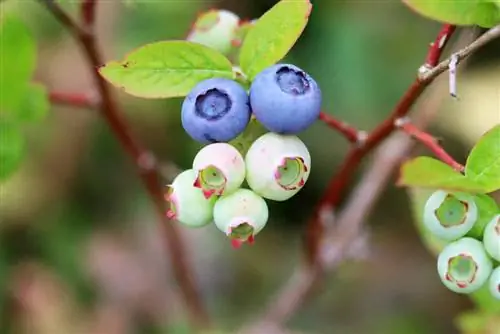
- Location: in pine and mixed forests
- Height: Dwarf shrub, 10 to 60 cm
- Leaves: grass green, 2 to 3 cm long, ovate to elliptic, slightly serrate to finely toothed
- Flowers: greenish to reddish
- Flowering time: April, May
- Fruits: maximum 1 cm large black-blue berries, solitary, slightly flattened, edible
Red foxglove,Foxweed, forest bell (Digitalis purpurea)
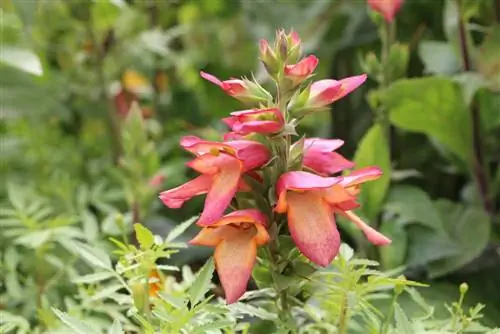
- Location: prefers sparse coniferous forest
- Height: up to 2 m high
- Leaves: basal leaf rosette in the first year, later basal leaves up to 20 cm long
- Flowers: red-purple flowers in racemose inflorescences
- Flowering time: June to August, only in the second year
- Special features: Deadly poisonous in all parts of the plant even in small quantities!
Smelly hellebore (Helleborus foetidus)
- Location: Oak and beech forests, forest edges, preferably slightly calcareous soil
- Height: up to approx. 60 cm
- Leaves: unpleasant smelling
- Flowers: light green, occasionally with a slightly reddish edge, in clusters, hanging, appear in autumn
- Flowering time: late winter, early spring
- Special features: Subshrub, poisonous
Deadnettle (Lamium)
- Height: 20 to 80 cm
- Leaves: opposite, hairy, bluntly notched to coarsely toothed
- Flowers: Lip blossoms, upper lip arched, lower lip multi-lobed, white, yellow, pink to purple
- Flowering time: depending on the variety from April until the first frost
Forest Goat's Beard (Aruncus dioicus)
- Height: 80 cm to 1.5 m
- Leaves: Leaves up to 1 m long, two to three in three or five parts, sharply toothed
- Flowers: white, small, spiked partial inflorescences arranged in panicles on overhanging entire inflorescences
- Flowering time: June to July
Forest Whitewort,Multi-flowered Whiteroot (Polygonatum multiflorum)
- Height: usually 30 to 60 cm, rarely up to 1 m
- Leaves: Upper side dark green, underside gray-green, alternate, two-lined, ovate to elliptical, 5 to 17 cm long
- Flowers: white with green tips, 6 to 7 mm long, odorless, racemose inflorescences with 3 to 5 flowers
- Flowering time: May to June
- Fruits: Dark blue to black berries, frosted, 7 to 9 mm in size
- Special features: poisonous in all parts of the plant
Vegetation of the shrub layer
The shrub layer is usually more pronounced in sparse forests and almost impossible to find in dark coniferous forests. Forest edges and clearings are particularly species-rich.
Blackberries (Rubus sectio rubus)
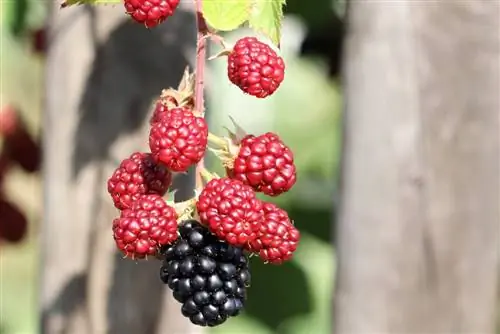
in sparse forests
Hazelnut (Corylus avellana)

in sparse forests, at the edges of forests
Raspberries (Rubus idaeus)
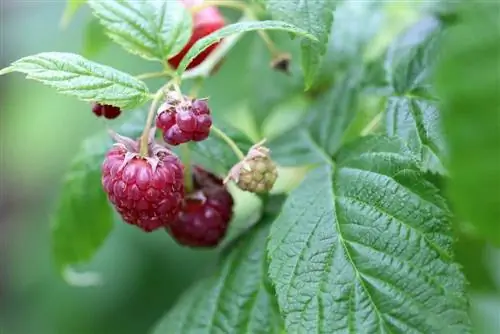
at the edges of forests and in clearings
Dog rose (Rosa canina)
in sparse forests and on the edges of forests
Blackthorn (Prunus spinosa)
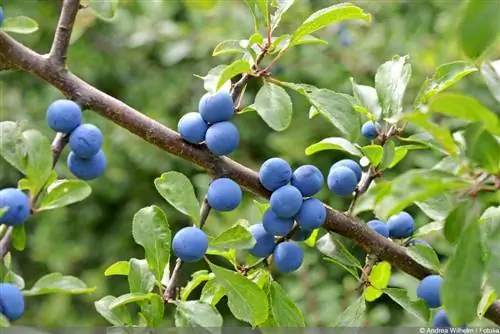
- at the edges of forests
- considered a butterfly plant
Black Elderberry (Sambucus nigra)
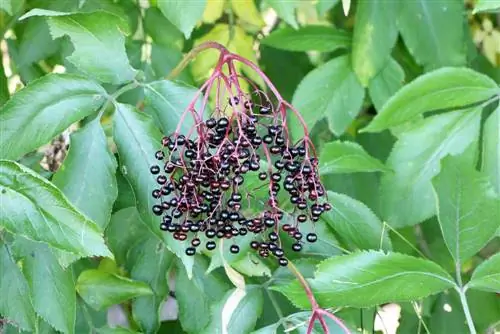
- in forest clearings
- unripe berries are poisonous
- ripe ones should only be consumed warm
Rowberry (Sorbus aucuparia)
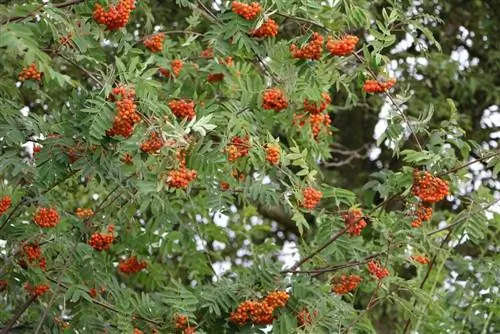
- small apple-like fruits
- important food plant for many animals
- in all forests, preferably at the edge of the forest
Hawthorn (Crataegus)
- in sparse deciduous and pine forests
- edible fruits
The tree layer
The tree layer is formed by the different deciduous and coniferous trees, probably the most important plants in the forest. You can find mainly spruces and beeches here, but also pines, firs, oaks, maples and larches and, increasingly, Douglas firs.
Native conifers
Douglas fir (Pseudotsuga menziesii)
- foreign coniferous tree (is grown for forestry in Europe)
- up to 50 m high
- Crown: conical, similar to the spruce
- Trunk: cylindrical, straight
- Bark: smooth, gray, with resin bumps, later reddish to dark brown, thick bark, deeply cracked
- Needles: soft, top green, bottom with 2 light stripes, flat, aromatic scent
- Cones: 5 to 10 cm long, hanging, light brown
Spruce (Picea abies)

- up to 50 m high
- Crown: slim, conical
- Trunk: columnar
- Bark: gray-brown to red-brown, thinly scaled
- Needles: dark green, square, sitting around the branch
- Cones: hanging, 10 to 16 cm long
Pine (Pinus sylvestris)

- up to 40 m high
- Crown: umbrella-like
- Trunk: mostly straight
- Bark: thick grey-brown bark below, thin, reddish-yellow and peeling on top
- Needles: 3 to 7 cm long, on short shoots, blue to gray-green
- Cones: egg-shaped, gray-brown, short-stemmed
Larch (Larix decidua)
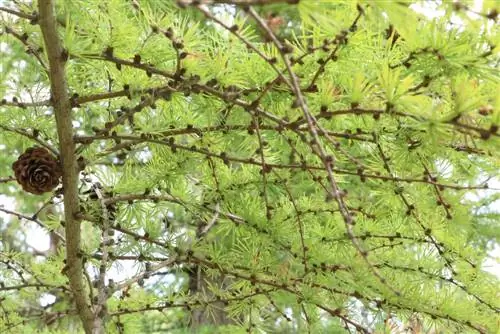
- up to 50 m high
- Crown: slightly conical
- Bark: deeply grooved, grey-brown, red inside
- Needles: soft, light green, in clusters on short shoots, golden yellow in autumn, needleless in winter
- Cones: 3 to 4 cm long, egg-shaped, brown, standing upright
(White) fir (Abies alba)
- up to 50 m high
- Crown: rather flattened, similar to a stork's nest
- Trunk: straight
- Bark: whitish to silver-grey, finely cracked
- Needles: Underside with 2 white vertical stripes, upper side dark green, flat
- Cones: only in the top area, standing upright, 10 to 15 cm long
Native deciduous trees
Sycamore maple (Acer pseudoplatanus)
- up to 30 m high
- Bark: smooth, brown-gray, later peeling off in light brownish flat scales
- Leaves: long-stemmed, opposite, 5-lobed (like 5 fingers), pointedly indented
- Fruits: composed of 2 winged round nuts
Norway Maple (Acer platanoides)
- up to 30 m high
- Bark: blackish, finely cracked, not flaking
- Leaves: 5 to 7 lobed, blunt cut (round), serrated
- Fruits: composed of 2 winged flat nuts
Ash (Fraxinus excelsior)
- up to 40 m high, but usually 15 to 20 m
- Crown: mostly light
- Trunk: long and straight
- Bark: first greenish, then gray to grey-brown, cracked
- Leaves: opposite, imparipinnate, usually 11 saw-toothed leaflets
- Fruits: small winged nuts, usually single-seeded, elongated, yellow-brown, in hanging, tufted panicles
Hornbeam (Carpinus betulus)
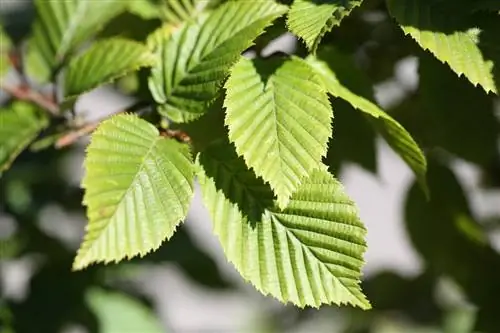
- up to 25 m high
- Trunk: strong indentations
- Bark: silver-gray, smooth
- Leaves: two-lined, alternate, pointed-egg-shaped, sharply double-serrated, folded along the parallel lateral veins
- Fruits: small nuts, single-seeded, in loosely hanging catkins
Common beech (Fagus sylvatica)
- up to 40 m high
- Trunk: long, straight
- Bark: smooth, silver gray
- Leaves: alternate, two-lined, edge smooth or slightly wavy
- Fruits: triangular beechnuts, shiny brown, prickly shell
Pedunculate oak (Quercus robur)
- up to 35 m high
- Crown: irregular, loose
- Trunk: Relatively short, early branching
- Bark: initially silver-gray, smooth and shiny, from around the 30th year gray-brown and deeply cracked
- Leaves: alternate in clusters, 4 to 5 rounded lobes on both sides
- Fruits: cylindrical acorns, in cup-shaped cups, 1 to 3 each on a long stem
Sessile oak (Quercus petraea)
- up to 40 m high
- Crown: irregular
- Trunk: long
- Bark: initially silver-gray, smooth and shiny, from around the 30th year gray-brown and deeply cracked
- Leaves: alternate, evenly distributed, 5 to 7 rounded lobes on both sides
- Fruits: cylindrical acorns, in cup-shaped cups, clustered in clusters (3 to 7) on a short stem
Special plants in the deciduous forest
So-called early bloomers can be found in many deciduous forests. They bloom in spring, before the trees leaf out and the thick foliage darkens the forest. Native early bloomers are a very important food source for insects as they provide the first nectar of the year.
Early flowering plants
Wild garlic, wild garlic, forest or dog garlic (Allium ursinum)
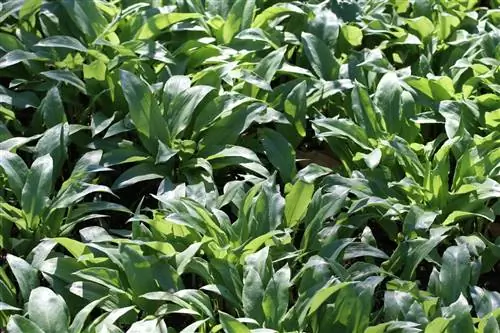
- preferred location: moist soils and beech forests
- Height: 20 to 30 cm
- Leaves: green, upper side slightly darker than underside, lanceolate, stalked
- Flowers: white, radially symmetrical flowers in flat umbels
- Flowering time: April to May
- Special features: Edible wild vegetables, related to onions, chives and garlic, taste slightly garlic-like
Likelihood of confusion:
Leaves can easily be confused with those of lily of the valley, the spotted arum (young leaves are unspotted) or the autumn crocus, these plants are highly poisonous!
Wood anemone (Anemone nemorosa)

- Height: 11 to 25 cm
- Leaves: stalked, finger-shaped, only appear after flowering
- Flowers: 6 to 8 petals, white, slightly pink on the outside, usually only one flower per plant, rarely 2
- Flowering time: March to April/May
Common Butterbur (Petasites officinalis)
- Height: during flowering approx. 10 to 40 cm, later up to 1.20 m
- Leaves: rounded, initially small with gray hairy underside, later up to 60 cm in diameter and smooth, similar to coltsfoot but much larger
- Flowers: numerous dense reddish-white to red-violet flowers, compound racemose inflorescence
- Flowering time: March to May
Ficaria, figroot (Ficaria verna, Ranunculus ficaria L.)
- Height: 10 to 20 cm
- Leaves: undivided on long stems, heart- to kidney-shaped
- Flowers: yellow, star-shaped, diameter 1.5 to 6 cm, solitary
- Flowering time: March to May
- Special features: poisonous in all parts, young leaves before flowering can be eaten as a wild herb
Woodruff,Sweet-smelling bedstraw (Galium odoratum)

- Height: 5 to 50 cm
- Leaves: whorled on the stem, narrow-elliptic or elongated-lanceolate, rough edge
- Flowers: small and white, several flowers per plant, terminal inflorescence
- Flowering time: variable depending on location, around April to May or June
- Special features: is used as a medicinal and seasoning herb, the main component of woodruff punch
Plant species in the coniferous forest
Sometimes different plants grow in coniferous forests than in deciduous forests. Shade plants especially feel at home here. This is due to the low level of light, as most conifers are needled all year round. The only exception to the domestic conifers is larch, which sheds its needles in autumn. In addition, the soil in coniferous forests is generally more acidic, the falling needles decay much more slowly than leaves, which means the humus layer is relatively thick. Wood sorrel, mosses and ferns can be found here, as well as red foxglove and common heather in clear areas.

